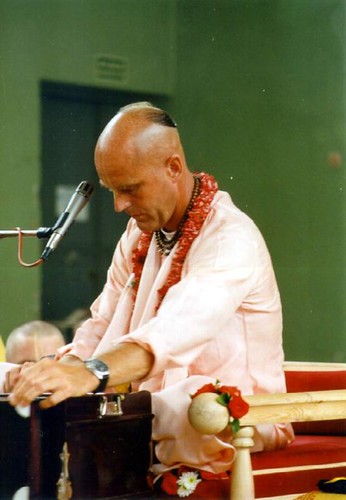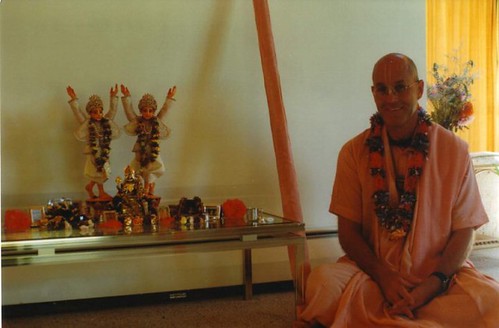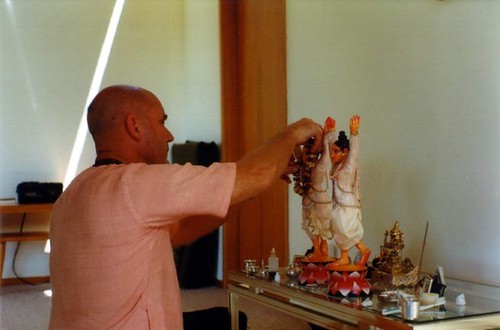por ISKCON desire tree
H H Indadyumna Swami

H H Indadyumna Swami

H H Indadyumna Swami

H H Indadyumna Swami

H H Indadyumna Swami

H H Indadyumna Swami

H H Indadyumna Swami

Prowess, de HARE KRISHNA
“You have advented Yourself to fulfill Your own statement that You come within this material world just to protect the principles of religion and annihilate unwanted miscreants.” (Narada Muni offering prayers to Lord Krishna, Krishna, the Supreme Personality of Godhead, Vol 1, Ch 36)
God is the most powerful, the all-omnipotent. Sometimes we forget the power that He has, or at other times we have trouble comprehending His greatness. For these and many other reasons, the Lord comes to earth from time to time to display His prowess, reminding us of His potencies.
God doesn’t do this to show off. The Vedas describe Him as atmarama, meaning self-satisfied. He is in need of nothing, for He can survive through any condition. Devotees, however, love to see the Lord in action. Similar to how people enjoy happy endings to stories, the pious like to be reminded of God’s greatness. It gives them a feeling of peace and serenity. There is so much that we encounter in our everyday lives that goes against God and His injunctions that it can be difficult to bear. Sinful activity is quite prevalent and it can lead to a distressful condition. During these desperate moments, the devotees pray for the Lord to personally appear and alleviate the situation.
“Your appearance and disappearance are made possible by Your inconceivable energy just to give protection to the faithful devotees and to annihilate the demons.” (Lord Brahma offering prayers to Lord Krishna, Krishna, the Supreme Personality of Godhead, Vol 1, Ch 14)
There is nothing that brings more pleasure to the devotees than seeing God victorious in His battles against the demons. These pastimes are so pleasing that people like to relive them over and over again. Through the grace of the great saints of India, many of these events have been recorded in written form in the various Puranas, Mahabharata, and Ramayana.
The other reason God chooses to personally display His prowess is to baffle the atheists. Since the beginning of time there has been an ongoing war between the daivas and the asuras. Daivas include demigods and the devotees of the Lord. The asuras are the atheists. The devotees are more than happy to execute their devotional service in a peaceful manner, not concerning themselves with those who are not interested in worshiping God. The asuras, however, see devotees as the biggest threat to their sinful way of life. Asuras have no belief in God, so essentially, they don’t believe in anything. Since their value system is so flimsy, they feel threatened by the devotees. For this reason, they try as hard as they can to disprove the existence of God. They go about this in several ways, with the primary method being the acquisition of great material wealth. “Look at me! I have so much power and money. These other people are so poor that they have taken to worshiping a God who doesn’t exist.” This was the mindset of famous demons like Ravana and Hiranyakashipu.
Another way atheists go about attempting to disprove the existence of God is through scientific research. The Vedas describe the difference between matter (prakriti), and spirit (purshua), but most scientists are only interested in matter. They believe that if they try hard enough, they can reach a point where they can create life from matter. They have yet to succeed, but that doesn’t stop them from trying. The fatal flaw in their logic stems from the fact that God is achintya, or inconceivable. The gross material senses can never truly comprehend the nature of God. Even the widely subscribed to Big Bang Theory can’t explain how the initial “bang” took place. We are incapable of fully understanding God because we living entities are part of God’s marginal energy, meaning we aren’t on the same level as God. Our intelligence is limited by the powers of our mind, which uses material objects as reference points.
The Dr. Frog analogy is appropriate in this regard. A frog living in a well all its life knows only of what it has experienced. If someone comes to the frog and tries to explain the size of the Pacific Ocean, the frog will naturally ask, “How big is this ocean? Is it bigger than this well?” The Pacific Ocean is infinitely larger than any well, yet the frog doesn’t know anything outside of his current habitation. This same principle can be applied on a macro level to all of human civilization. Even with the invention of various spaceships such as the Mars rover, we still don’t have the slightest clue into how large the universe actually is; such is the nature of God and His powers of creation.
One of God’s appearances on earth took place many thousands of years ago in the town of Ayodhya. When the Lord appears in human form, He likes to take birth in a kshatriya family, because it is the duty of the kshatriya warriors to provide protection to the rest of society. Lord Rama was the greatest kshatriya warrior. Both He and His younger brother, Lakshmana, were trained by the great sages Vashishta and Vishvamitra. The brahmanas are the highest class in the varnashrama dharma system since they dedicate all their time to studying the Vedas and performing various sacrifices and rituals. Since brahmanas are directly engaged in serving God, they have perfect knowledge of all material subjects. They can train others not only on priestly matters, but on all areas relating to fighting and defense. Vishvamitra, being pleased with the respect shown to him by Rama and Lakshmana, imparted on them various mantras. The recitation of these mantras would turn an ordinary bow and arrow into a weapon equal to the magnitude of a nuclear bomb. A mantra is a sound vibration uttered for a particular purpose. The entire Vedic system revolves around mantras. Sound vibrations are very powerful, so the flawless recitation of a mantra can yield great results.
“Who is there, proud of his fighting prowess, that shall be able to withstand me when I appear on the battlefield holding a bow with my fingers covered by a shield made of alligator-skin? Killing one with a number of arrows, and sometimes many with a single one, I shall drive shafts into the vital organs of men, horses, and elephants. Oh Lord, today I shall display the strength of my arrows by removing the king’s power and making You the Supreme Lord.” (Lakshmana speaking to Lord Rama, Valmiki Ramayana, Ayodhya Kand, 23.34-36)
Rama was the rightful heir to the throne, but His father, King Dasharatha, instead chose Rama’s younger brother, Bharata, to succeed him. In conjunction, Rama was ordered to spend fourteen years in the forest as an exile. Lakshmana didn’t take these orders very well and he tried his hardest to get Rama to defy them. He proposed to Rama the idea of a coup, with himself leading the fight against any enemies. The above referenced statement was part of Lakshmana’s arguments intended to persuade Rama.
Lakshmana’s words weren’t exaggerations. He was Rama’s brother and also an incarnation of Ananta Shesha Naga, who is almost as potent as God Himself. The two brothers fought and killed many demons during their time on earth. On one occasion, Lord Rama personally slaughtered 14,000 Rakshasa aggressors in Janasthana. These Rakshasas were all associates of Ravana, sent by him to go to Janasthana and kill Rama. These historical accounts aren’t exaggerations or mythology. Killing that many Rakshasas is mere child’s play for Lord Rama and for Lakshmana as well.
Rama appreciated Lakshmana’s mood of devotion, but eventually decided against the coup idea. Instead, Rama abided by the exile order but allowed Lakshmana and Sita Devi, Rama’s wife, to accompany Him. Lakshmana was able to display His prowess while in the forest and also later on during the battle to rescue Sita from Ravana’s kingdom of Lanka.
The lesson here is that God is great. This is a fact agreed upon by all the major religions of the world. The Vedas, being the original scripture for mankind, go one step further by describing just how great God is. His name, form, expansions, pastimes, and attributes are described in great detail in the various Vedic texts. Other religions of the world may have one or two books they consider as scripture, but the Vedas have volumes and volumes of books detailing God’s glories. Originally this information was passed down through an oral tradition, but due to the kindness of the great sages, they were eventually put into written form. Each one of these books is very large, for the Mahabharata alone contains around 100,000 verses. If we simply set aside a little time to read these books every day, keeping a mood of faith and humility, we too can take great pleasure in God’s victories.




Página PRINCIPAL
OBRAS y AUTORES CLÁSICOS
Agradecimientos
Cuadro General
Disculpen las Molestias
| Conceptos Hinduistas (1428)SC |
|---|
Category:Hindu (mythology) (3256)SC | Category:Hindu mythology (3270)SC | Categoría:Mitología hindú (3288)SC (indice) | Categoría:Mitología hindú (videos) (3289)SC | Conceptos Hinduista (A - G) SK y SC (videos) (3294)SC Aa-Anc · Aga - Ahy · Ai - Akshay · Akshe - Amshum · Ana - Ancie · Ang - Asvayu · Ata - Az · Baa-Baz · Be-Bhak · Bhal-Bu · C · Daa-Daz · De · Dha-Dry · Du-Dy · E · F · Gaa-Gayu · Ge-Gy · Ha-He · Hi-Hy · I · J · K · Ka - Kam · Kan - Khatu · Ki - Ko · Kr - Ku · L · M · N · O · P · R · S · Saa-San · Sap-Shy · Si-Sy · Ta - Te · U · V · Ve-Vy · Y · Z |
| Conceptos Hinduistas (2919)SK | (2592)SK |
|---|
Aa-Ag · Ah-Am · Ana-Anc · And-Anu · Ap-Ar · As-Ax · Ay-Az · Baa-Baq · Bar-Baz · Be-Bhak · Bhal-Bhy · Bo-Bu · Bra · Brh-Bry · Bu-Bz · Caa-Caq · Car-Cay · Ce-Cha · Che-Chi · Cho-Chu · Ci-Cn · Co-Cy · Daa-Dan · Dar-Day · De · Dha-Dny · Do-Dy · Ea-Eo · Ep-Ez · Faa-Fy · Gaa-Gaq · Gar-Gaz · Ge-Gn · Go · Gra-Gy · Haa-Haq · Har-Haz · He-Hindk · Hindu-Histo · Ho-Hy · Ia-Iq · Ir-Is · It-Iy · Jaa-Jaq · Jar-Jay · Je-Jn · Jo-Jy · Kaa-Kaq · Kar-Kaz · Ke-Kh · Ko · Kr · Ku - Kz · Laa-Laq · Lar-Lay · Le-Ln · Lo-Ly · Maa-Mag · Mah · Mai-Maj · Mak-Maq · Mar-Maz · Mb-Mn · Mo-Mz · Naa-Naq · Nar-Naz · Nb-Nn · No-Nz · Oa-Oz · Paa-Paq · Par-Paz · Pe-Ph · Po-Py · Raa-Raq · Rar-Raz · Re-Rn · Ro-Ry · Saa-Sam · San-Sar · Sas-Sg · Sha-Shy · Sia-Sil · Sim-Sn · So - Sq · Sr - St · Su-Sz · Taa-Taq · Tar-Tay · Te-Tn · To-Ty · Ua-Uq · Ur-Us · Vaa-Vaq · Var-Vaz · Ve · Vi-Vn · Vo-Vy · Waa-Wi · Wo-Wy · Yaa-Yav · Ye-Yiy · Yo-Yu · Zaa-Zy |
















No hay comentarios:
Publicar un comentario